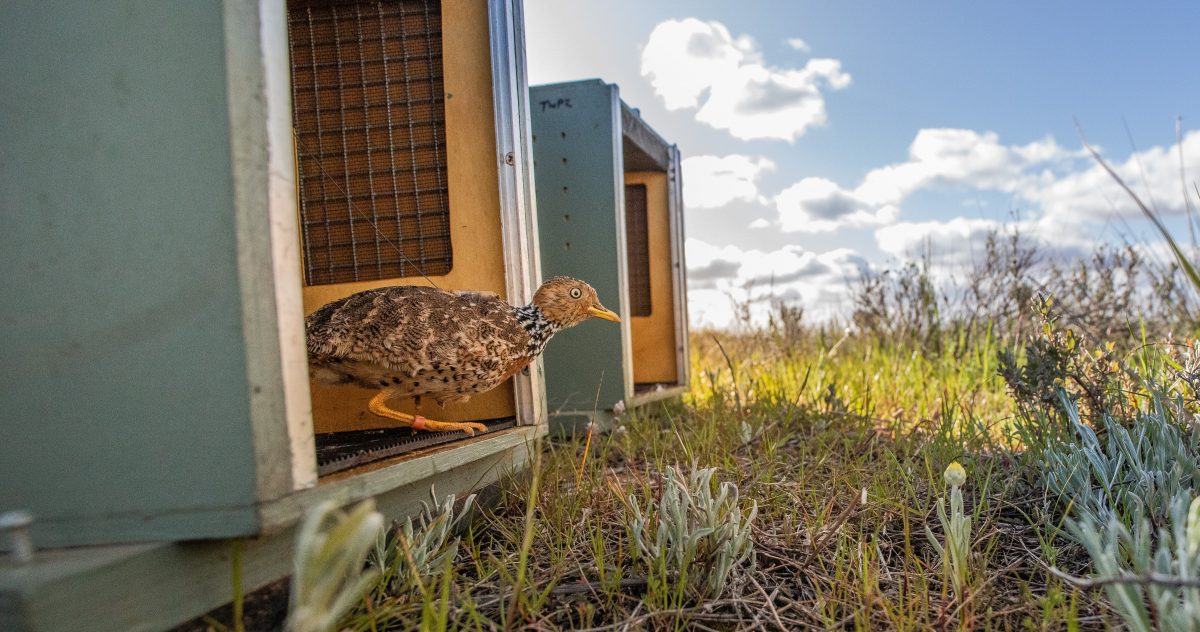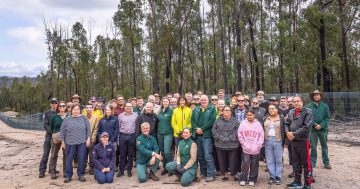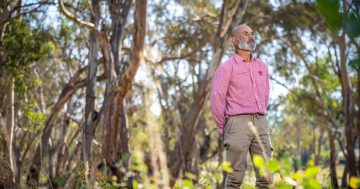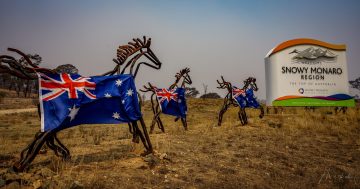
Fifteen endangered plains-wanderer birds have been released into Oolambeyan National Park in the Riverina wearing tiny, solar-powered satellite backpacks. Image: Zoos Victoria
Out in the Riverina exists a bird so ancient, so rare and so close to extinction tiny, solar-powered satellite backpacks are now being used to track them.
Carrying those packs is a 15-strong cohort – selected from national plains-wanderer conservation breeding programs – last month released into Oolambeyan National Park and charged with the mission of gathering long-term data that scientists hope will hold the key to the species’ survival.
Researchers have previously struggled to understand the movements of the endangered plains-wanderer in the wild, but the tiny tracking devices are expected to shed new light on their behaviour.
The mid-September release marked the second release of the species back into the wild in NSW as part of an intervention program that has already notched up five years of effort from scientists, conservationists, government agencies and landholders.
The plains-wanderer, nicknamed the “Goldilocks bird” for its proclivity for pristine conditions, is an ancient species with no equivalent in Australia; the 12-15 cm lanky quail-like creature is actually more closely related to wading birds in South America, the result of the connection of the two continents as part of Gondwana more than 60 million years ago.
Once relatively widespread throughout the sparse arid grasslands of eastern Australia, the population has dwindled to an estimated 250 to 1000, now restricted to small strongholds in the Riverina and Northern Plains of Victoria.

Each backpack unit is programmed to regulate battery charging for continuous transmission, providing data for up to two years via satellite tracking. Image: Zoos Victoria.
The ground-dwelling species has long been in the crosshairs of agricultural development, habitat loss, severe drought and fox and feral cat attacks.
If they become extinct, says NSW Environment Minister James Griffin, the world will lose the last remaining species in the genus.
“They’re a critical part of the ecosystem because their presence or absence is an indicator of the health of their native habitat,” he said.
Mr Griffin said the recent release was the culmination of years of conservation work aimed at bringing the species back from the brink.
“The second NSW release comes after 10 birds were released near Hay in March, and 16 in Victoria in 2021 as part of a national recovery program to save the species from extinction,” he said.
In an exceptional show of community resolve, with Oolambeyan National Park at its core and bordered by Griffith, Jerilderie, Hay and Goolgowi, around 30 landholders have committed to managing nearly 14,000 hectares of primary habitat under the Paddocks for Plains-Wanderers project, which aims to maintain suitable grassland that allows the plains-wanderer to survive.
These landholders, with a handful of incentives, have been working to improve the condition of plains-wanderer habitat on their properties by using stock-proof fencing, strategic grassland grazing management and undertaking pest and weed control.
Property-scale baiting across the project area and establishment of three landscape-scale intensive predator control programs, has resulted in the removal of an estimated 7000 foxes.
This is the first ever plains-wanderer release in Australia to use satellite technology to track the endangered species.
Previously-released birds could only be tracked with transmitters in the field which was limited by a 12-week backpack battery life.
The new technology, sourced from United States-based Microwave Telemetry, comprises a rechargeable battery powered by high-efficiency miniature solar cells.
Each unit is programmed to regulate battery charging for continuous transmission, providing data for up to two years via satellite tracking.
“These solar backpack-wearing plains-wanderers are paving the way for us to gather important data, which will ultimately help us improve our conservation efforts for wild populations into the future,” the minister said.
Oolambeyan National Park was protected in perpetuity in 2002 due to its high conservation value in protecting critical habitat for the plains-wanderer.
The release of the birds is part of the NSW Government’s Saving our Species program, which is backed by a $175 million commitment over 10 years.
Original Article published by Edwina Mason on Region Riverina.











